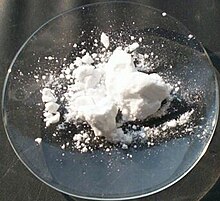Trisodium phosphate

| |

| |
| Names | |
|---|---|
| IUPAC name
Trisodium phosphate
| |
| Other names
Sodium phosphate tribasic
| |
| Identifiers | |
| ECHA InfoCard | 100.028.645 |
| EC Number |
|
| E number | E339(iii) (antioxidants, ...) |
| RTECS number |
|
CompTox Dashboard (EPA)
|
|
| Properties | |
| Na3PO4 | |
| Molar mass | 163.94 g/mol |
| Density | 1.620 g/cm3 (dodecahydrate) |
| Melting point | 73.5 °C decomp. (dodecahydrate) |
| 1.5 g/100 ml (0 °C) | |
| Basicity (pKb) | 2.23 |
| Structure | |
| Trigonal | |
| Hazards | |
| Flash point | Non-flammable |
| Related compounds | |
Other anions
|
Sodium arsenate Sodium antimonate Sodium bismuthate |
Other cations
|
Trilithium phosphate Tripotassium phosphate |
Except where otherwise noted, data are given for materials in their standard state (at 25 °C [77 °F], 100 kPa).
| |
Trisodium phosphate (TSP), available at most hardware stores in white powder form, is a cleaning agent, food additive, stain remover and degreaser, commonly used to prepare surfaces for painting. It can also be called trisodium orthophosphate and has the chemical formula Na3PO4; however, it is generally found in hydrated forms. It is a highly water-soluble ionic salt. Solutions of it dissolved in water have an alkaline pH.
Other sodium phosphates, sometimes known by E number E339, are food additives and used as an acidity regulator (buffering agent), emulsifier, thickening agent, nutrition enlargement agent and sequestrant (metal-chelating agent). Sodium phosphate enemas are sold over-the-counter in the United States, as a laxative to treat constipation. However, these should not be confused with the related compounds sodium dihydrogen phosphate, also known as monosodium phosphate or MSP, and disodium phosphate.
TSP for cleaning

Similar chemicals were once common in laundry and dishwashing detergents, but the phosphate, being a fertilizer, would cause algal blooms in the bodies of water into which the drains led. In the early 1970s the use of phosphate-containing products was limited. Now products sold as TSP Substitute, containing 80–90% sodium carbonate, are promoted as a direct substitute, however, sodium carbonate is not as strongly basic as trisodium phosphate. This makes it less hazardous to use, but less effective in demanding applications.
Cleaning products labeled as TSP may contain other ingredients as well, and may in fact be less than half TSP.[2] So even "regular" TSP found at the hardware store may be half TSP and half "TSP substitute".
Although it is the active ingredient in at least one toilet bowl cleaning tablet[citation needed], TSP is generally not good for cleaning bathrooms because it can corrode metal and can damage grout. [3]
TSP is commonly used after cleaning with mineral spirits in order to then clean up all the mineral spirits.[citation needed] TSP may be used with household chlorine bleach in the same solution without hazardous reactions [4]. This mixture is particularly good for removing mildew. The TSP alone can cause dark stains on redwood, and bleach prevents it [citation needed]
TSP is used in various forms as a boiler treatment chemical for calcium precipitation, and also to regulate the caustic effects of disodium phosphate in coordinated phosphate chemistry.[citation needed]
